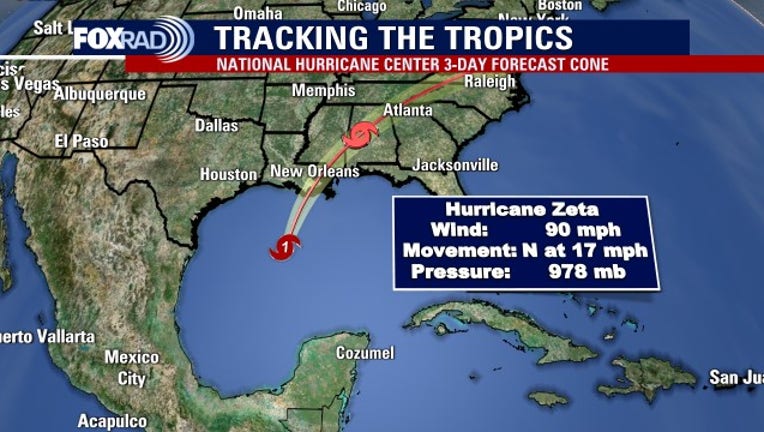Zeta makes landfall in Louisiana as category 2 hurricane

Louisiana is bracing for what could be a category 2 hurricane. Zeta will be a very fast-moving storm, but wind damage and coastal flooding is likely for SE Louisiana, Mississippi and Alabama. A cold front will prevent any impacts on the Texas coast o
NEW ORLEANS - Hurricane Zeta has officially made landfall along the Texas Gulf Coast on Wednesday afternoon.
According to the National Hurricane Center, Zeta made landfall as a category 2 hurricane near Cocodrie, Louisiana with maximum sustained winds around 110 miles per hour.
Louisiana has had the worst of it, already been hit by two tropical storms and two hurricanes. New Orleans has been in the warning area for potential tropical cyclones seven times this year, each one veering to the east or west.
“I don’t think we’re going to be as lucky with this one,” city emergency director Colin Arnold said.
As Zeta approached, New Orleans officials announced that a turbine that generates power to the city’s aging drainage pump system broke down on Sunday, with no quick repair in sight. There was enough power to keep the pumps operating if needed, but little excess power to tap if other turbines fail, officials said at a news conference with Mayor LaToya Cantrell.
SIGN UP FOR FOX 26 HOUSTON EMAIL ALERTS
Officials said they were running through contingencies to provide power and make repairs where needed should there be other equipment problems. Forecasts called for anywhere from 2 to 6 inches (5 to 15 centimeters) of rain to fall in the New Orleans area, but Zeta is expected to be a relatively fast-moving storm, possibly mitigating the flood threat.
Zeta raked across Mexico’s Yucatan Peninsula Tuesday, weakening to a tropical storm over land before strengthening again over the Gulf of Mexico. It’s following path not too different from Hurricane Laura, which was blamed for at least 27 Louisiana deaths after it struck in August, and Hurricane Delta, which exacerbated Laura’s damage in the same area just weeks later.

Strong winds lash Mexico as Hurricane Zeta approaches
Hurricane Zeta hit Mexico on October 26, bringing maximum sustained winds of 80 miles per hour, according to the National Oceanic and Atmospheric Association. Footage shows strong winds in Cancún, on the Yucatán Peninsula. Credit: Lisa Hwang via Storyful
Early Wednesday, Zeta’s top winds grew to 90 mph (150 kph) and its forward movement increased to 17 mph (28 kph) as its center moved north, about 265 mph (430 kph) south of the mouth of the Mississippi River.
Hurricane warnings stretched from Morgan City, Louisiana to the Alabama/Mississippi state line, including Lake Pontchartrain and metropolitan New Orleans. Tropical storm warnings were in effect for the western Florida Panhandle, forcing early-voting sites to close for hours in three counties where Republicans dominate.
The center of Zeta should make landfall in southeastern Louisiana in the afternoon, then move over Mississippi in the evening before crossing the southeastern and eastern United States on Thursday, the hurricane center said.
Louisiana Gov. John Bel Edwards asked President Donald Trump for a disaster declaration ahead of the storm. He and Alabama Gov. Kay Ivey both declared emergencies, as did Mayor Andrew “FoFo” Gilich in Biloxi, Mississippi. Trump declared an emergency for Louisiana Tuesday evening.
“There’s no doubt that we’ve seen a lot this year, with COVID and so many threats from so many storms,” Gilich said in a news release, “but this storm shows that we haven’t seen it all yet.”
Zeta broke the previous record for a 27th named Atlantic storm, taking shape more than a month before that one on Nov. 29, 2005. It’s also this season’s 11th hurricane. An average season sees six hurricanes and 12 named storms.

Zeta strips trees at Cancún Resort
Minor damage was seen to trees at a resort in Cancún, Mexico, on October 27 after Tropical Storm Zeta made landfall as a Category 1 hurricane. (Credit: Now Boarding Travel via Storyful)
The extraordinarily busy hurricane season has focused attention on the role of climate change, which scientists say is causing wetter, stronger and more destructive storms.
With yet another storm approaching, worries accumulated for people left homeless. The state is sheltering about 3,600 evacuees from Laura and Delta, most in New Orleans area hotels.
“I’m physically and mentally tired,” a distraught Yolanda Lockett of Lake Charles said, standing outside a New Orleans hotel.
MORE TROPICAL WEATHER UPDATES FROM FOX 26
Meanwhile, many along the coast renewed an unwanted ritual of preparation.
On Dauphin Island, off the Alabama coast, workers at Dauphin Island Marina prepared for Zeta, although in some places there was little left to protect after Hurricane Sally hit in September.
“We don’t have any docks or fuel pumps at this point. Sally took it all out,” employee Jess Dwaileebe said.
In Louisiana’s coastal St. Bernard Parish, east of New Orleans, Robert Campo readied his marina for another onslaught. “We’re down for four or five days, that’s four or five days nobody’s fishing. That’s four or five days nobody is shrimping. That’s four or five days, no economic wheels are turning,” he said.
“I’ve never seen anything like it,” said Thomas Hymel, an extension agent in Jeanerette with the LSU Agricultural Center. He said the storms have meant more than a month of down time for seafood harvesters, many of whom are already suffering a drop in demand from restaurants due to the coronavirus pandemic.
___
Santana reported from Shell Beach, Louisiana. Associated Press reporters Jay Reeves, in Birmingham, Alabama; Melinda Deslatte in Baton Rouge, Louisiana; Stacey Plaisance in New Orleans; Seth Borenstein in Kensington, Maryland, and Gabriel Alcocer in Cancun, Mexico, contributed to this report.

